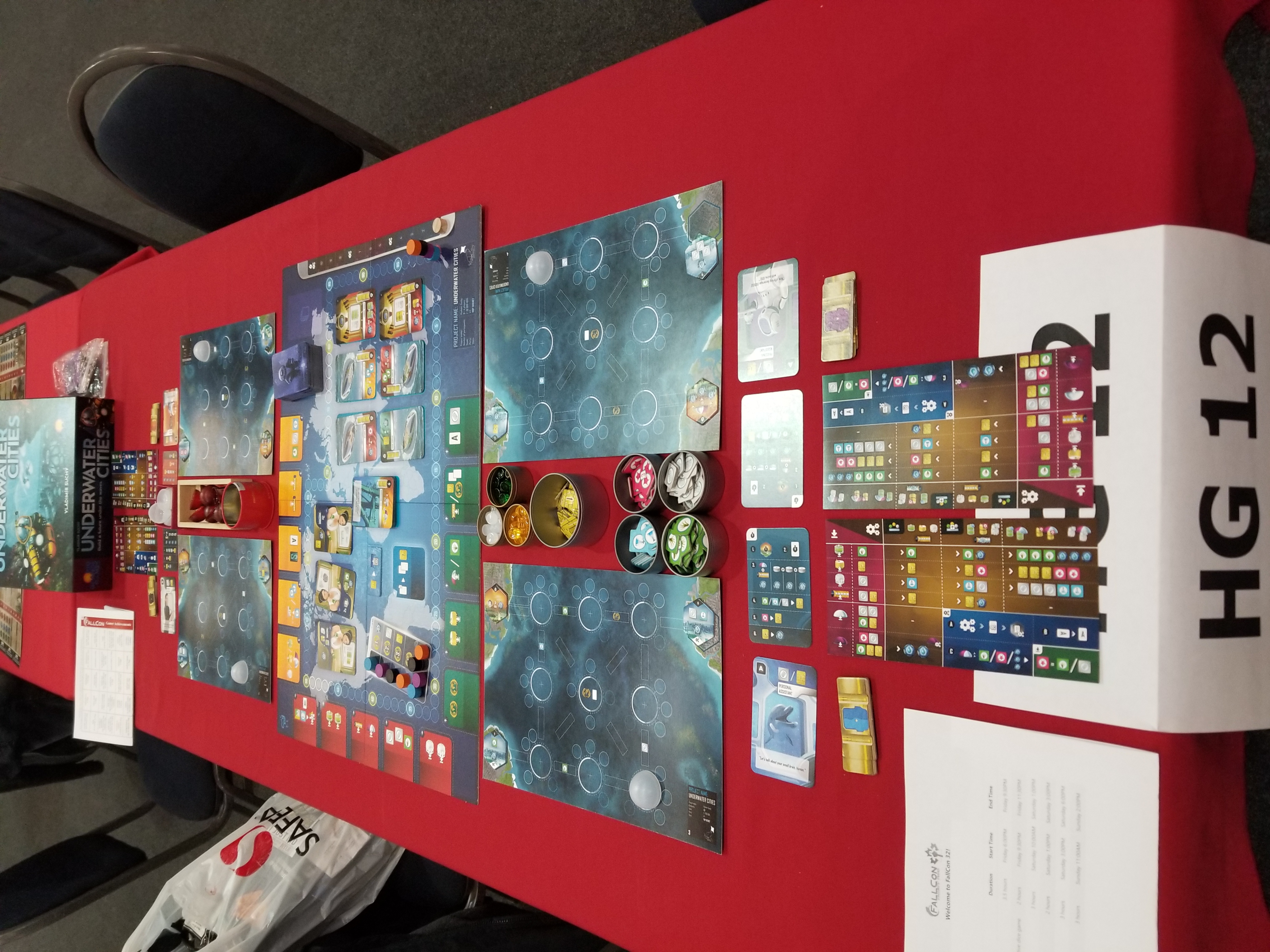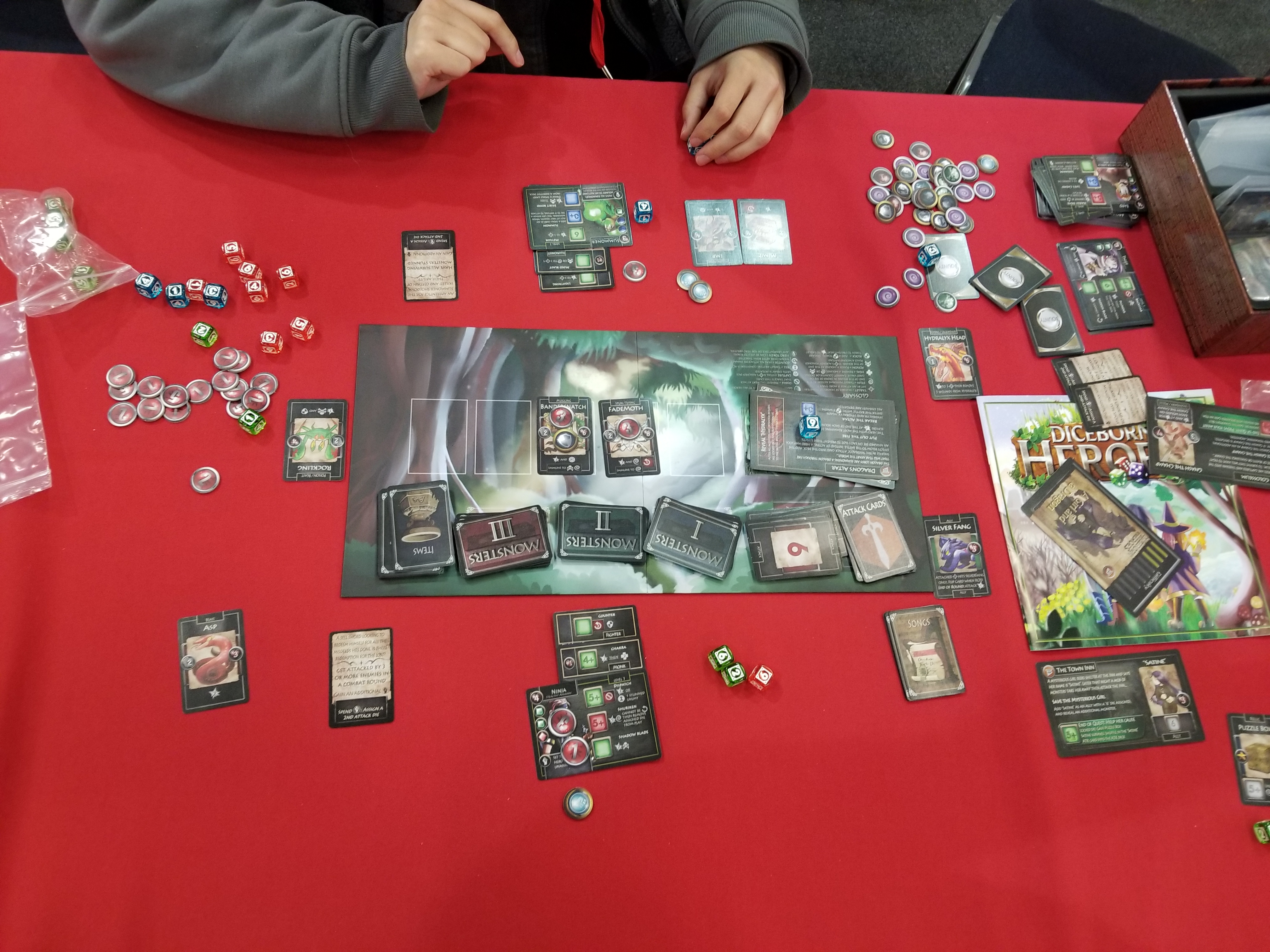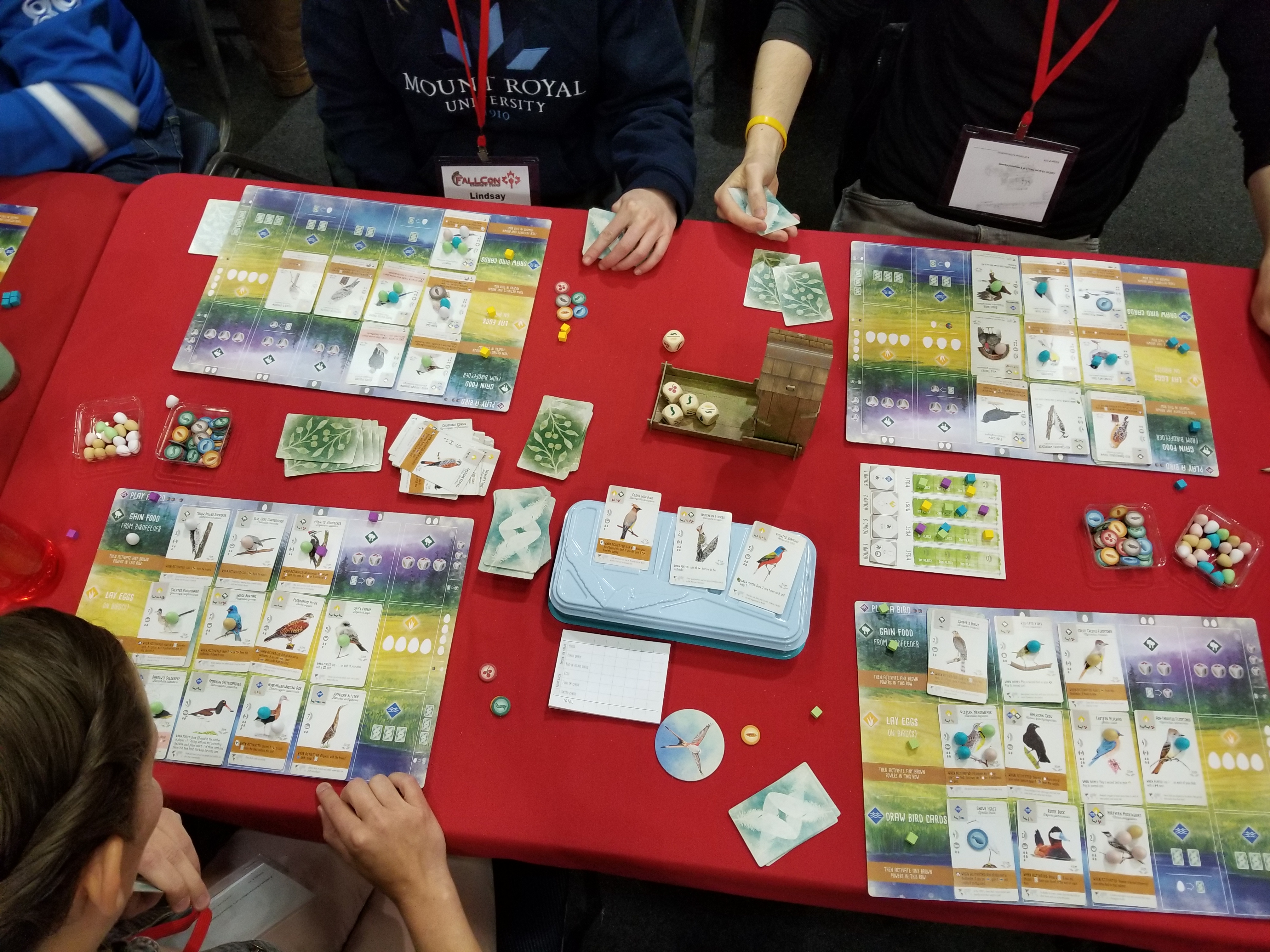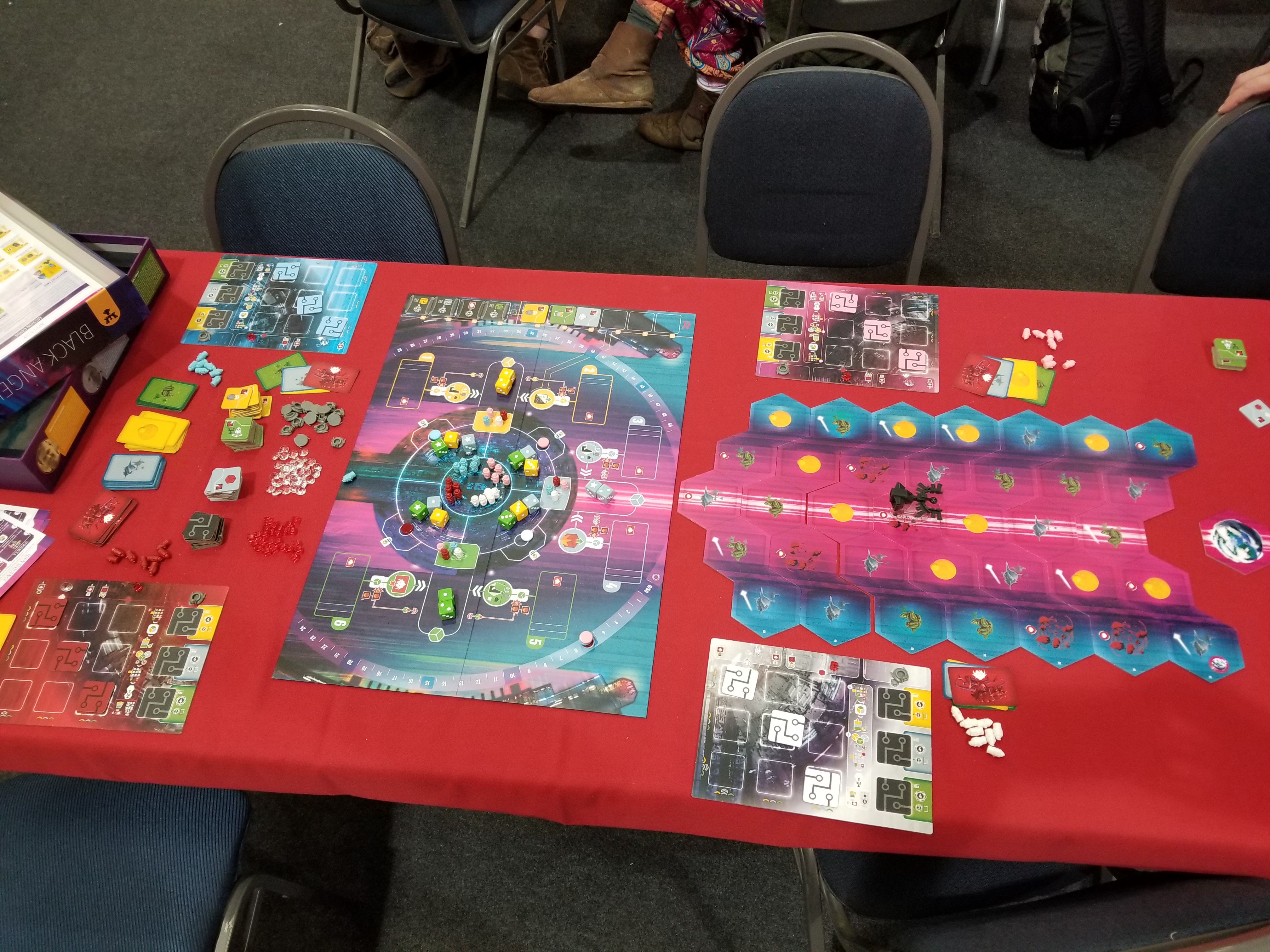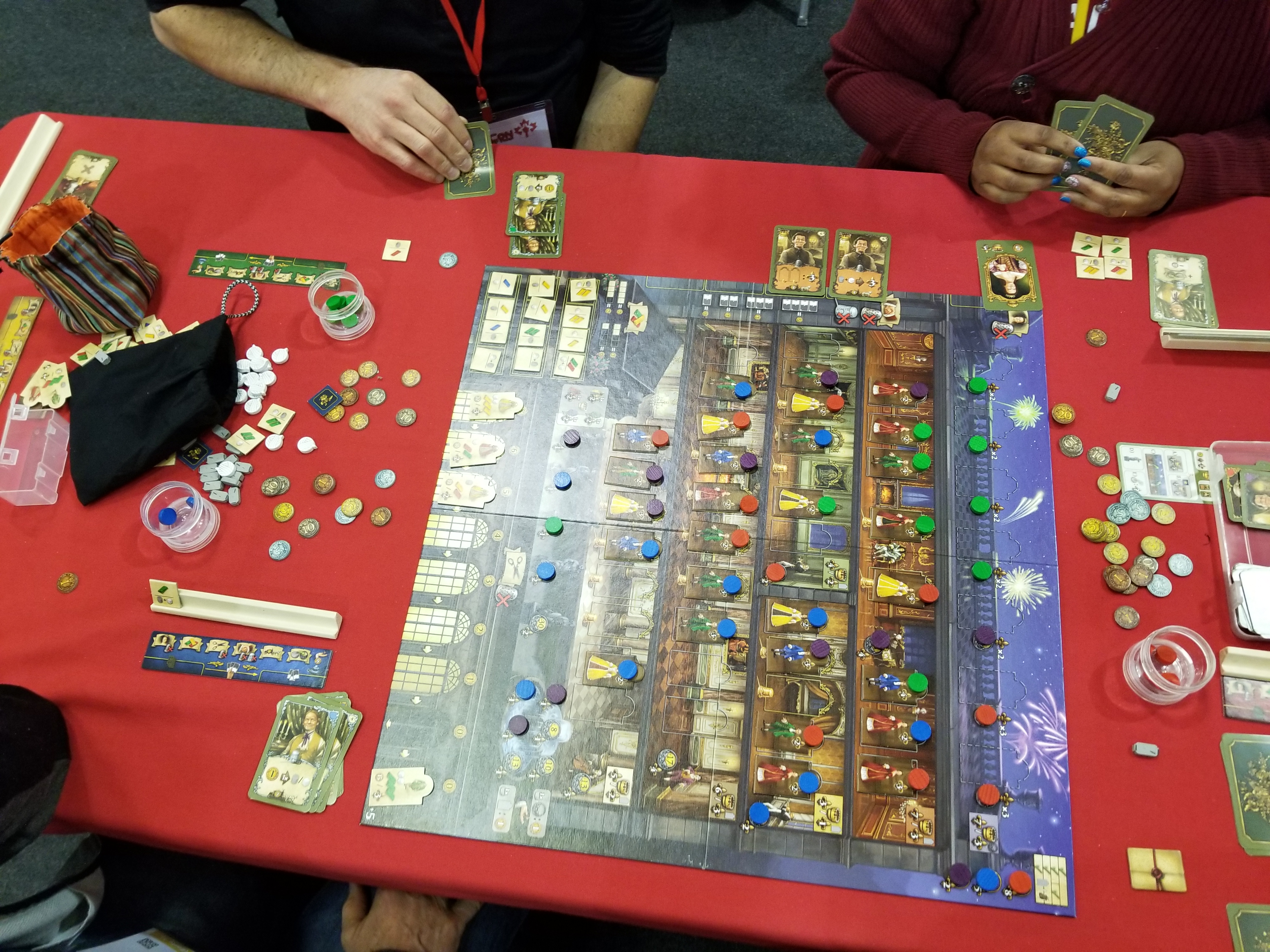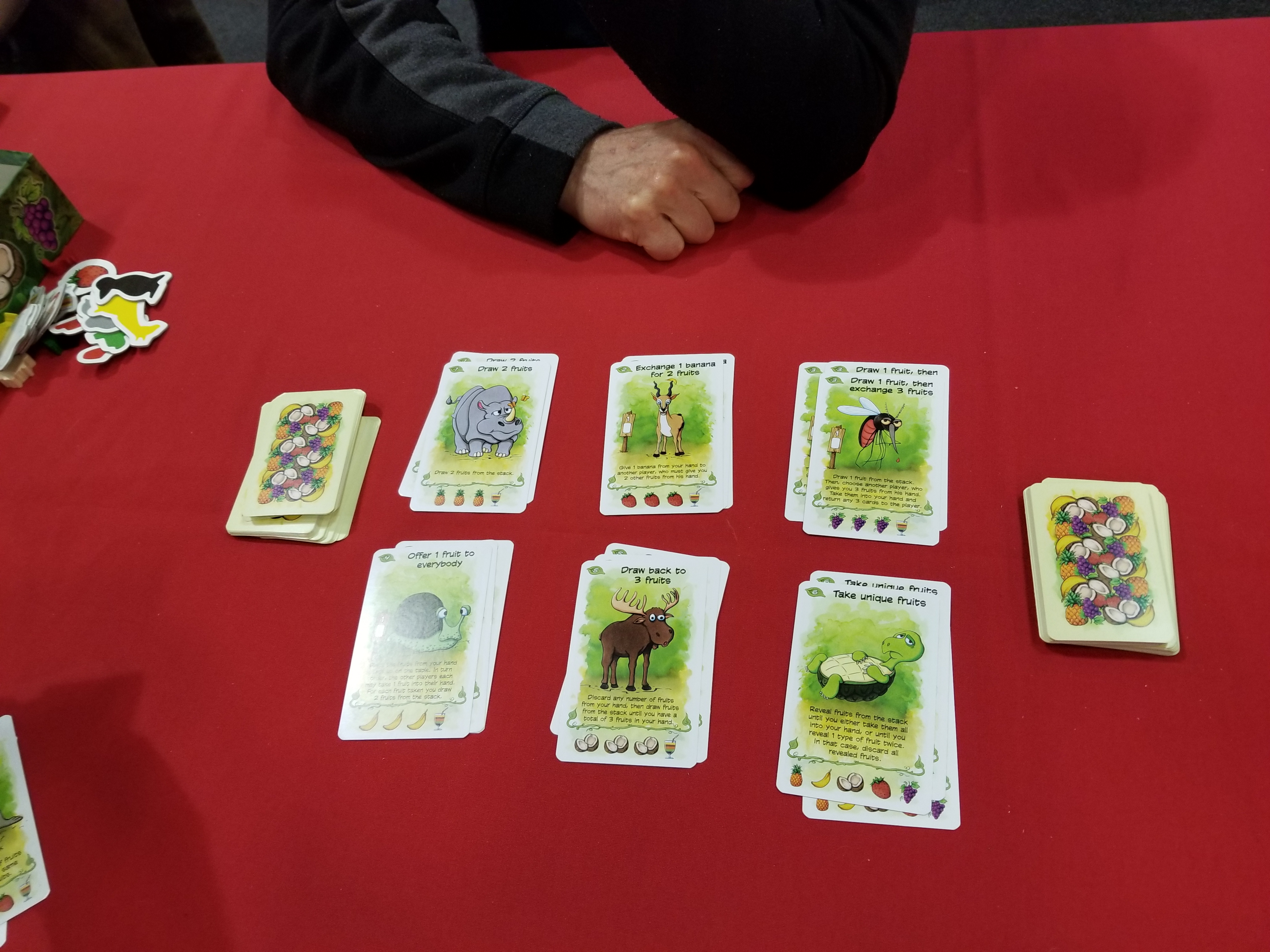FallCon is an annual Calgary boardgaming convention. This year was number 32! It’s 28 hours of gaming goodness that includes hosted events, a massive game library and open gaming area, an auction and flea market, merchants, and even has an escape room and an Artemis Bridge Simulator area.
Before going further, let me just say how great the FallCon team is. Every team member I interacted with was happy to be there. Every game host taught with patience and enthusiasm. From Brent’s warm welcome at the door that first night to the “see you next year” as I left Sunday afternoon, everybody was smiling and helpful. And the fellow attendees were similarly great. I’ve yet to have an unpleasant experience at the table (knocks on wood), and you start to recognize people from year to year. The venue is also great—easy to get to, plenty of room, and a few food options nearby. It’s just a great way to spend a weekend.
I’m a planner, and I usually go to FallCon solo, so the hosted events are my favourite. I know exactly what and when I’m going to play, and somebody else teaches the game. FallCon also gives me a chance to play games I can’t usually get to the table. Since I play mostly with my nieces and nephews or at family gatherings, I play a lot of lighter games—and I do enjoy them, don’t get me wrong—but I really do love a solid medium-weight, 2–4 hour euro game. It’s just really hard to get them to the table. This year there were plenty to choose from.
Here are my thoughts on the various games I played, in the order I played them. I’ll give the good, the not so good, and a final verdict. But first, a blanket caveat: all the games I played were new to me, and, with one exception, I only played each game once. These are first impressions only.
- Underwater Cities
- Diceborn Heroes
- Wingspan
- Teotihuacan: City of Gods
- CO2
- Black Angel
- Rococo
- Fabled Fruit
Underwater Cities
This game includes worker placement, city/network building, and hand management. Each player has their own player mat on which they try to build the most valuable underwater complex. You select actions from the board that let you do things like play cards from your hand, gather resources, build things on your tableau, and affect the turn order.
The Good
-
It’s not “mean.” There are no cards that steal resources from another player or directly affect another player’s tableau. That doesn’t mean there’s no player interaction, though. Players are constantly jockeying for turn order, and the worker placement mechanic here is quite tight. You will be “scooped” often (someone takes the action you wanted before you can). And there’s competition for powerful special cards.
-
Because of the competitive worker placement, turn order is really important. I found this layer of interaction added an interesting and engaging level of tension.
-
There’s an interesting balancing act between maximizing resource production during the game and maximizing end-game scoring. For example, having one of each type of building around a dome nets you the most end-game points, but having multiple buildings of the same type generates more revenue during the game.
-
You only produce resources periodically, and then you have to ration those resources for a number of turns. This forces you to make interesting choices.
The Not So Good
-
The production values are only adequate. I certainly wouldn’t call it attractive. And while that’s not necessarily a deal breaker, with so many great games out there with incredible production values, it’s certainly something that can sway a purchasing decision.
-
I often found myself with no objectively good option, especially after being scooped. I don’t mind having to be flexible and find a different way to reach my goal, but I want to feel at least somewhat enthusiastic about my options.
-
The cards didn’t wow me. Most of the time, when drafting new cards, there was only one or two out of six that I had any use for. But one of the other players did manage to build a decent engine, so maybe it was just luck of the draw.
-
The game just felt slow. I don’t mean how long it took to play, just that you are always resource poor, and cards seemed to do so little most of the time. This ties into the feeling of not having many good choices. There’s something delicious about having so many things you want to do and not being able to do them all (I talk about this in a number of games later on), but that’s not the feeling I got in this game. I simply felt blocked.
The Verdict
I liked it and would definitely play it again, but I don’t plan on adding it to my collection.
It took four first-time players three hours to finish the game.
Diceborn Heroes
This was a Kickstarter game designed by a Calgary designer. It’s a cooperative game where a team of fantasy heroes fight through several waves of enemies trying to complete a series of quests, leading to a boss fight. Each turn you roll some coloured dice and assign one of them to one of the powers on your card or sometimes to the quest card itself. Then attack cards are revealed for each monster, and combat resolves. Between each round you can level up your hero by adding a new power or by evolving into a stronger character with new powers. And depending on meeting certain criteria, additional special cards may be added to the game. If you defeat the boss, you all win. But you need to do so before the attack deck runs out.
The Good
-
The art style is cute, and there are multiple versions of the same card for the different sexes.
-
The components are decent quality. The dice are translucent and attractive, and the cards felt sturdy.
-
The levelling mechanic is interesting.
-
There are some interesting hero classes (the Summoner, for example, who can bring back defeated monsters to fight for you).
The Not So Good
-
The decision space is very small. On many of my turns, because of the numbers I rolled, I had no choice as to what to do. You start with three powers and two dice. By the end of the game I had five powers and three dice, and the more powerful abilities required 5s or 6s to activate. Well when you roll snake eyes, and you only have one slot with no number requirement, decision made. Also, the way enemies target heroes is deterministic and hard to alter. There’s no way I saw to “taunt” an enemy to keep it off your weaker teammates.
-
The “story pack” we played through was completely disjointed. There was no relation either between the three quests or the quests and the final boss. You could have just shuffled together all the quests of a given level and just chosen one at random. Given they were called “story packs,” I expected some sort of narrative arc.
-
The rule book was problematic. It was aesthetically off-putting (lacked polish and basic design features). I also found it poorly organized. I didn’t read the whole book, but whenever I dove in to find a particular rule or situation, I struggled to find what I needed or even know where to start looking. Given the quality of the rest of the components, this surprised me.
The Verdict
I just don’t think this game is for me. There weren’t enough interesting decisions for me to make. I felt like I was just observing.
I don’t think I can recommend it because there are just so many incredible games in the world, and more and more coming out every year, that it just doesn’t make sense to spend money on something that doesn’t wow you.
Wingspan
This game is the definition of “new hotness.” It’s the designer’s first published game, yet it won the most prestigious game award in the industry: the Kennerspiel des Jahres . So it has been the talk of the town. It was so popular that they ran hosted sessions throughout the whole convention! I found it hard to believe the hype, so I was excited to try it out for myself.
This is a card-based engine-building game. You are trying to attract the most valuable birds to your sanctuary. The birds themselves and the eggs they lay are worth points, but also each round has a randomized scoring goal, and each player has a secret goal on top of that.
Cards are played to your tableau in one of three habitats (rows). These rows also represent different actions you can take on your turn. As you place more cards in a row, the more powerful that particular action becomes. And when you activate a given row, you also get to activate the special powers of every card in that row.
The Good
-
The components are gorgeous! First of all, the cards are beautifully illustrated and contain interesting little tidbits about the pictured bird (there are 170 unique birds in the deck). And the powers of the different birds are mostly thematic (there are about 40 basic powers spread across the 170 bird cards). Additionally, there’s a thematic little birdhouse dice tower for rolling the oversized and clearly marked food dice. And then you have the beautifully thematic little coloured eggs. It looks great on the table! And the game comes with great containers for the cards and bits.
-
As with Underwater Cities , it’s not mean. There are powers that trigger on other people’s turns, but there’s no way for you to directly interfere with another person’s tableau. Griefing other players really only happens as you fight over the food supply. This makes the game much more appealing to a wider audience.
-
There are only four actions you can take (play a bird, take food, lay eggs, and take cards), so the initial decision space is relatively easy to manage, but deciding when to do what and balancing immediate needs with the long-term scoring goals leads to interesting decisions. I never felt there was an objective “right move” for me to make on any turn. I was always evaluating and planning.
-
Good engine-building games provide a certain intrinsic reward. It just feels great to build and exploit a powerful synergistic set of cards. It makes people smile. I saw that smile in both the games I played.
-
And again, the cards are gorgeous.
The Not So Good
- As with any card game, there’s a certain randomness involved. You need to be prepared to go with the flow and adjust your strategy as you go, but yes it’s possible to get a starting hand that just doesn’t jive with the round’s scoring goal.
The Verdict
I’m definitely adding this game to my collection. It’s hard to find at the moment (they clearly didn’t expect the game to win the Kennerspiel), but I’m confident it will see many plays over the coming years. It’s a great gateway-plus game with a broadly appealing theme that’s easy to teach and pleasant to play.
It took four first-time players two hours to play a game, and my second game took just under 90 minutes with two first-time players. This is the only game at the convention I was able to play twice.
Teotihuacan: City of Gods
Players command a force of worker dice that grow stronger as you use them. On your turn, you move a die around the board, landing on a specific action space. Actions include gathering resources, gaining technology, and building the great Pyramid of the Sun in the centre of the board. Actions can also gain you prestige on various tracks. At the end of three years, whoever has accumulated the most points wins.
The Good
-
I really liked the dice evolution mechanic. A higher-numbered die gives you a stronger action, as does having multiple dice on a space. After an action, one or more of your dice go up a number. Higher dice eat more food at the end of the year, though! When a die reaches a 6, it “ascends,” gaining you a bonus, but resetting back to 1.
-
The player interaction here was also engaging. There’s nothing stopping you from taking an action someone else has taken, but doing so costs more based on the number of different dice already in the space. I never felt truly blocked. There was always something I could do. It was just about finding the optimal path. Also, ascending a die moves the round marker up, and finishing the temple immediately ends the game, so you can squeeze your opponents if you can get a solid lead.
-
Though I only played once, I could see the replayability potential. Bonuses in the various action spaces and tracks are randomized, and there are optional boards you can replace certain action spaces with for variety. Even starting resources are randomized in a really interesting way, letting you set up an initial strategy.
-
The components are excellent, and the printing on the board is large and clear. The temple tiles are nice and chunky.
The Not So Good
- It is very daunting when you first look at it. It’s icon salad. It’s not so bad once you know what it all means, but it takes some work to teach.
The Verdict
I really liked this game, and the more time passed, the more fond of it I grew. It made my brain hurt in a really good way. Finding that optimal path and dealing with the occasional setback was really fun. I actually bought it before leaving the convention. This hit a real sweet spot for me. It was full of interesting and sometimes difficult choices while also being relatively clear. I can see myself getting this to table at least once in a while.
The box says up to two hours. The teacher and three first-timers played in almost three. I can see it getting faster once you’re familiar with the game.
CO2
This game involves area control and tile placement. Typically the game is cooperative. We ended up playing the competitive variant. The goal is to collectively keep the CO2 levels in the atmosphere from breaching a certain threshold while also accumulating more points than your opponents. You do this by building zero-emission energy plants of different types in regions around the world. This is a three-step process. First, someone needs to propose a project of a specific type in a specific region. This nets them resources in the form of government grants. Then someone needs to build the infrastructure for that plant, which also earns some resources. Finally, someone pays to ultimately build the plant. Doing so gets you influence in that region. Having the most influence in a region gets you access to other government resources that will make it easier to build more plants in the future.
But to build a plant, you also need to have sufficient knowledge. So you send your scientists to different projects and ultimately to conferences to level up your knowledge.
Throughout, you’ll be able to play lobbyist cards that give you bonuses for doing certain actions in certain places. And eventually you will also qualify for UN bonus scoring cards.
Driving the tension are the crisis tiles. Every decade, a new region will experience a spike in demand. If you don’t do something in that region, you will end up paying through the nose instead.
At the end of each decade, you look in each region. If a clean energy plant was not built there, you draw a polluting energy plant from a bag and add those emissions to your total. If you ever breach a certain threshold, game over. But if you manage to get through five decades, then you win, and in our case, the person with the most points wins individually.
The Good
-
The components were nice and sturdy, and the graphic design was clean and relatively clear. The second edition pieces were very attractive and thematic.
-
The player board made it very clear what your options were on your turn.
The Not So Good
-
I felt very constrained turn to turn. I had very few interesting choices.
-
The three-step building process was so tedious. I don’t doubt its verisimiltude, but as a game mechanic, I found it off-putting.
-
There wasn’t enough drama or tension. Sure you felt pressured to build in one of the crisis areas, but if you didn’t, it just cost you some personal resources. There was no effect on the game board. With games like Pandemic and Defenders of the Realm, you can see in advance what areas are going to become a problem. There’s real suspense as the event cards get drawn, and real drama when an outbreak happens.
-
The blind draw of dirty plants meant you couldn’t plan around them. Sure there’s a little tension around “will it be a 20 or a 40,” but since it’s completely out of your control, there’s no reason to get invested.
-
The experience system felt completely tacked on. It was just there to add a new mechanic. It didn’t feel necessary, interesting, or fun.
The Verdict
If you can’t tell yet, this was the only game I actively disliked. I was so bored! The game has complexity on top of complexity for no apparent reason. Maybe it’s because we played the competitive variant. I’d be willing to try this one more time as a pure co-op, but I don’t see how the core experience will change. On every turn I never felt like I had a good option. I just focused on my secret goal card and pretty much ignored the events. I hardly touched my lobbyist cards and never came close to a UN card. I just found the game utterly baffling.
Black Angel
This game is hard to categorize. There’s some dice rolling, which you use as workers, and some hand management, but there are some unique elements as well. We were not able to finish the game in the time we had.
The Black Angel is a spacecraft filled with the genetic heritage of humanity sent out to find a new planet. The ship is run by a number of AI programs (the players) and a crew of robots. As the ship is now approaching a habitable planet, players build relationships with friendly alien races, fend off the Ravagers, and try to optimize their own personal programs in order to score points. The AI who earns the most by the time the ship reaches the new planet wins.
Each player has a player board with a 3×3 grid. As you gain new technology, you’ll add it to this board. You can use cards representing the various alien races to activate matching technologies on your board. There are also special endgame technologies that earn you points at the end of the game.
You also have a certain number of robots to work with. You use robots to earn you dice and to go outside the ship to complete missions for points and other resources.
And you use dice to perform various actions around the ship, including going out to do missions, buying new technology, fighting off Ravagers, and repairing damage to the ship.
The Good
-
The components are nice—that big Black Angel figurine, in particular.
-
The Sequence A vs. Sequence B decision you have to make and that moves the game forward is unique and interesting.
The Not So Good
-
The iconography is not intuitive. You have to simply learn what it all means.
-
It’s quite random. A bad dice roll will really wreck your day. To be fair, there are ways of mitigating it. Paying one kind of resource lets you flip a die, increasing or decreasing it by 2. And paying another kind of resource lets you buy dice from other people. But it’s not like you’re rolling in resources.
-
People can buy your dice! I just don’t like this sort of player interaction, especially in longer games. It is mitigated by the fact that they have to pay you directly to do so, so you could conceivably turn around and buy another die back, but it can really mess with your plans.
-
It is quite complex. It took almost an hour to teach it. There were just lots of little nuances. And the game (as much as I played it) just didn’t seem to warrant some of those nuances.
The Verdict
I’m uncertain. It doesn’t help we weren’t able to actually finish a game. I’d be willing to try this again, but I’m definitely not looking to pick this one up. It just didn’t grab me the way Teotihuacan did, for example.
We had four first-time players, and we got about two-thirds through the game in two hours.
Rococo
This is a game about making dresses. It’s the eighteenth century during the reign of Louis the Fifteenth. He’s throwing a lavish ball, and you want your dresses to be the most noticed. So you send out your workers to buy fabrics, make dresses, and fund decorations in preparation. But not all workers can do all tasks, so you have to manage them carefully.
You need fabric to make dresses. When you make a dress, you can either sell it for cash or you can rent it to an attendee at the ball and place the dress in one of the palace’s five halls. You can also fund decorations that either earn you points directly, earn you income over time, score sets of different coloured dresses, or that earn you score multipliers at the end of the game. You can also hire new workers, the power of which get progressively stronger as the rounds progress. In the final rounds, powerful endgame scoring workers become available.
When the day of the party arrives, you score points for your various dresses as well as points for having the most dresses in each of the halls. And if you played your cards right, some of your dresses will end up on the palace roof to watch the fireworks, earning you bonus points. Whoever earns the most prestige wins.
The Good
-
The theme is really unique. Just when you thought you’ve seen it all…
-
The art is functional and attractive. The graphic design is relatively clear (though I wish the difference between the lower two worker classes were more obvious).
-
It had that good feeling of “so much I want to do but so little time.” It was surprisingly deep.
-
It has the good kind of player interaction. There was stiff competition for valuable dresses and hall space bonuses, so it was nice and tense. But you can’t take things from other players directly.
The Not So Good
-
There were a couple workers that felt really overpowered. I’m referring to the later ones that let you take an extra sewing action with various discounts. It’s not like the dresses get more expensive as the rounds progress—they’re selected randomly—so those discounts can let you get a lot of dresses out in a turn. The player that had them didn’t win, but they went from last to second place pretty quickly.
-
I’m not convinced that all the apparent strategies are equally viable. Those decorations are very expensive, and money is in relatively short supply. I only sold one dress and instead focused on getting as many dresses on the board as early as I could. The only decorations I bought were the 3× multipliers on the roof and one at the very end to break a tie for control of a hall. And I won by a wide margin. I’d need to play more to experiment with different approaches.
-
It takes a while to play, longer than you might expect and longer than I fear some players may want to sit for a game of this weight. Our game consisted of the teacher and three first-time players and it took us close to three hours. I’m sure it gets faster with more plays. But you definitely want to keep the game under the two-hour mark.
The Verdict
I really liked the game and definitely want to play it again. I might even consider buying it if it ever comes back into print. I think the theme will be appealing to a number of people I play games with.
Fabled Fruit
The designer (Friedemann Friese ) famously hates rule books and the pain of learning new games. He wanted to create games that you could just sit down and start playing. This game is part of a series where he explores just that.
The game consists of multiple copies of (I think) 50 different cards representing a different animal. Each card also has a unique rule on it and a set of fruit cards that animal is looking for. You start with the cards numbered 1–6 on the table and players take turns moving their worker from card to card, doing what the card says. The goal is to collect fruit cards (five different kinds, if I remember right) and play sets to satisfy the different animals. The trick is that when you do this, you draw a new card from the sorted deck, which usually introduces a new location you can move to and thus a new rule. This way the game is always changing and you learn as you go. The winner is the one who earns a certain number of animal cards.
The game is designed so that you can put it away after a session and then pick up where you left off. Over multiple games, you eventually work your way through the entire deck, having very different experiences along the way.
Our game host modified the rules a bit so we could see more of the cards. We got up to number 10, I think.
The Good
-
The art is gorgeous. It’s brightly coloured and fun. Kids will love it.
-
The game is super easy to learn, by design. Just dive in and get started.
The Not So Good
- It’s just really light. Not a bad thing, but it’s appeal will be somewhat limited.
The Verdict
I really enjoyed it. If you have kids and you play games regularly, this is definitely one to look into. I don’t think I’ll add it to my personal collection (it just won’t get the plays), but I’ll certainly consider it as a gift for other gaming families.
